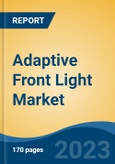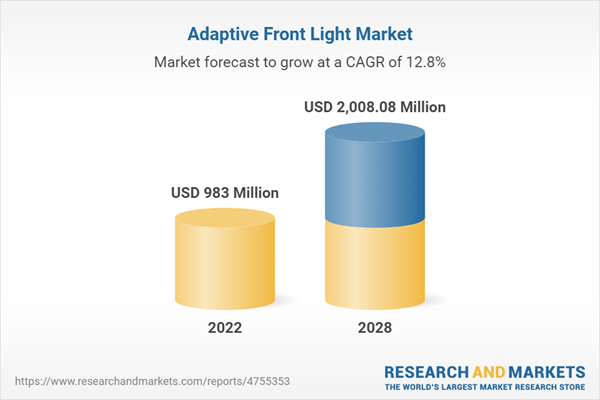Speak directly to the analyst to clarify any post sales queries you may have.
10% Free customizationThis report comes with 10% free customization, enabling you to add data that meets your specific business needs.
Key Market Drivers
Enhanced Road Safety
The primary driver behind the adoption of AFL systems is the emphasis on road safety. These systems dynamically adjust the direction and intensity of headlights, providing optimal illumination in various driving conditions. By improving visibility during night driving, adverse weather, and challenging road scenarios, AFL systems help reduce the risk of accidents caused by reduced visibility and inadequate lighting.Technological Advancements in Lighting
Rapid advancements in lighting technology, particularly the transition from traditional halogen lights to LED and laser-based headlights, have driven the development of AFL systems. These advanced lighting technologies offer greater control over light distribution, intensity, and adaptability, making them well-suited for implementing adaptive front lighting functionalities.Consumer Demand for Safety and Comfort
Consumers are increasingly seeking vehicles equipped with advanced safety features that enhance driving comfort and confidence. AFL systems align with this demand, offering a superior lighting experience that not only improves safety but also contributes to overall driving satisfaction. These systems cater to consumers who prioritize both safety and the driving experience.Regulatory Support and Standardization
Governments and regulatory bodies recognize the safety benefits of AFL systems and are introducing guidelines and standards for adaptive lighting technology. Regulatory support provides a clear framework for manufacturers to develop and implement AFL systems that adhere to safety and performance criteria. This alignment encourages automakers to integrate AFL systems to meet these standards.Improved Aesthetics and Differentiation
AFL systems not only enhance safety but also contribute to the visual aesthetics of vehicles. Automakers have realized that advanced lighting technology can differentiate their vehicles in a competitive market, making them more appealing to consumers. Distinctive headlight designs and advanced lighting features can serve as unique selling points for automakers.Integration with Advanced Driver Assistance Systems (ADAS)
AFL technology is often integrated with other ADAS features to create a holistic safety package. The ability of AFL systems to adapt to steering angle, vehicle speed, and road conditions complements other ADAS technologies, such as adaptive cruise control and lane departure warning systems, creating a comprehensive safety net.
Key Market Challenges
Technical Complexity and Reliability
AFL systems are technologically complex, relying on precise control of light distribution, intensity, and direction. Ensuring the reliable performance of these systems across various driving conditions, including adverse weather and dynamic road scenarios, presents a significant challenge. Robust design, high-quality components, and thorough testing are essential to maintain consistent and dependable AFL functionality.Regulatory Variability
Different regions and countries have varying regulations and standards related to headlight intensity, beam patterns, and adaptive lighting features. Manufacturers must navigate a complex landscape of regulatory requirements to ensure that their AFL systems comply with safety and performance standards in different markets. This can lead to additional development costs and delays.User Acceptance and Education
AFL systems offer advanced lighting capabilities that might be unfamiliar to some drivers. Educating users about the benefits, operation, and limitations of AFL technology is crucial to ensure its effective use. Drivers need to understand how AFL systems adapt to various conditions and how to maximize their safety benefits while avoiding potential distractions or misuse.Integration with Vehicle Electronics
Modern vehicles are equipped with a multitude of electronic systems and sensors. Integrating AFL systems with these existing components, as well as with other advanced driver assistance systems, can be challenging. Ensuring seamless communication and coordination among these systems is essential to avoid conflicts and ensure consistent performance.Lighting System Complexity
AFL systems often incorporate various technologies, such as swiveling or pivoting headlights, dynamic cornering lights, and adaptive beam shaping. The integration of these features can increase the complexity of the lighting system, making design, manufacturing, and maintenance more intricate. Ensuring the reliability and longevity of these components is a challenge that manufacturers must address.Cost and Affordability
While the cost of AFL systems has been decreasing over time, they still represent an additional expense for vehicle manufacturers. Striking a balance between providing advanced lighting technology and maintaining affordability for consumers can be challenging, especially in price-sensitive market segments.Environmental Factors
AFL systems rely on sensitive sensors and electronics that can be affected by environmental factors such as extreme temperatures, humidity, and debris accumulation. Ensuring the durability and functionality of these components in various environmental conditions is a challenge that manufacturers need to tackle.Key Market Trends
LED and Laser Lighting Advancements
The transition from traditional halogen lights to LED and laser-based headlights is a significant trend in the AFL market. LED and laser technologies offer greater energy efficiency, longer lifespan, and the ability to precisely control light distribution. This enables more sophisticated adaptive lighting features, enhancing safety and visibility for drivers.Matrix and Pixel Lighting Systems
Matrix lighting systems use multiple individually controlled LEDs to create dynamic lighting patterns. Pixel lighting systems take this concept further, enabling even finer control of light segments. These technologies allow precise adaptation of the light beam, enabling drivers to maintain high-beam illumination without blinding other road users. This trend is particularly relevant for AFL systems, as it enhances both safety and driver comfort.Integration with Vehicle Electronics and Connectivity
AFL systems are increasingly integrated into the vehicle's electronic architecture and connected networks. These systems can communicate with other vehicle sensors, cameras, and GPS data to optimize lighting patterns based on road conditions, traffic, and driving scenarios. This integration enhances the adaptability of AFL systems and contributes to safer and more efficient driving.Adaptive Lighting for Autonomous Driving
As vehicles move towards higher levels of autonomy, adaptive lighting becomes even more critical. AFL systems can enhance the vehicle's perception of the road and surroundings, improving its ability to respond to the environment. Adaptive lighting can illuminate road signs, pedestrians, and potential hazards, helping autonomous vehicles navigate safely.Personalization and User Experience
AFL systems are becoming more customizable, allowing drivers to tailor lighting preferences to their individual needs. These preferences can include light intensity, color temperature, and ambient lighting. Customization options enhance the overall driving experience, making the vehicle's interior and exterior lighting feel personalized and comfortable.Dynamic Lighting in Communication
AFL systems are being used for dynamic communication between vehicles and pedestrians. For instance, a vehicle could project signals on the road to indicate its intention to turn or stop, enhancing communication in scenarios where conventional turn signals might not be clearly visible.Energy Efficiency and Sustainability
As the automotive industry shifts towards electric and hybrid vehicles, energy efficiency becomes a key consideration. LED and laser-based AFL systems are inherently more energy-efficient than traditional halogen lights, contributing to the overall efficiency and sustainability of the vehicle.Segmental Insights
Vehicle Type Insights
Passenger cars held the highest market share of adaptive front-light (AFL) systems globally. This dominance can be attributed to several factors that distinguish the passenger car segment from commercial vehicles. Passenger cars encompass a wide range of vehicle types, from compact cars to luxury vehicles, catering to a diverse consumer base with varying preferences and needs. This diversity translates into a larger market for advanced features such as AFL systems. Consumers of passenger cars often prioritize safety, comfort, and cutting-edge technology, making them more receptive to innovative features like adaptive front lighting. Furthermore, the adoption of advanced technology tends to be swifter in the passenger car segment compared to commercial vehicles. Passenger car manufacturers have a strong incentive to incorporate AFL systems to stay competitive and meet consumer demands for improved safety and driving experiences. These systems enhance visibility during night driving and inclement weather, directly addressing consumer concerns about safety.Sensor Type Insights
LED (Light Emitting Diode) technology has the maximum market share globally in the adaptive automotive front light (AFL) market. LED headlights have gained widespread adoption due to several compelling advantages that have positioned them as the preferred choice for automotive lighting. LED headlights offer exceptional energy efficiency, longevity, and versatility. They consume less power compared to traditional halogen lights and provide brighter illumination, contributing to improved visibility and safety on the road. This energy efficiency is particularly important in modern vehicles, including electric and hybrid vehicles, where minimizing energy consumption is crucial for extending battery life and optimizing overall efficiency. The longevity of LED headlights is another significant factor driving their market share. LED bulbs have a longer operational life compared to conventional halogen bulbs, reducing the need for frequent replacements. This not only saves costs for vehicle owners but also contributes to sustainability by reducing waste generated from discarded bulbs. LED technology's flexibility allows for intricate control over light distribution and intensity. This adaptability is essential for adaptive front lighting systems, as it enables the dynamic adjustments required for different driving scenarios, such as cornering, highway cruising, and urban driving. LED technology can be integrated into matrix lighting systems, enabling precise control over individual light segments and enhancing safety by reducing glare for other road users.Regional Insights
Asia currently dominates the market for automotive adaptive front lights, led by the booming automotive industry in China, Japan, and South Korea. These countries are major players in the global automotive market, with a strong focus on technological advancements and innovation. Renowned automotive manufacturers in these regions, along with increasing consumer demand for safer and more advanced vehicle features, have fueled the growth of the automotive adaptive front-light sector. The Asian market's inclination towards innovative technologies has created a competitive landscape, with companies constantly pushing the boundaries of lighting systems. This drive for innovation has not only propelled Asia to the forefront of the automotive adaptive front-light market but has also resulted in cutting-edge solutions that enhance vehicle safety and visibility. Strict government regulations regarding road safety have played a significant role in driving the adoption of automotive adaptive front lights in Asia. These regulations ensure compliance with the highest safety standards and encourage manufacturers to incorporate advanced lighting technologies into their vehicles. Asia continues to strengthen its leading position in the global market, setting the benchmark for other regions to follow.Key Market Players
- Valeo SA
- Hella KGaA Hueck & Co.
- Robert Bosch GmbH
- Stanley Electric Co., Ltd.
- Magneti Marelli SpA
- Hyundai Mobis
- Osram Licht AG
- Continental AG
- Denso Corporation
Report Scope:
In this report, the Global Adaptive Front Light Market has been segmented into the following categories, in addition to the industry trends, which have also been detailed below:Global Adaptive Front Light Market, By Vehicle Type:
- Passenger Cars
- Motorcycles
- Commercial Vehicles
Global Adaptive Front Light Market, By Technology:
- Xenon
- LED
- Laser
- OLED
Global Adaptive Front Light Market, By Region:
- Asia-Pacific
- Europe & CIS
- North America
- South America
- Middle East & Africa
Competitive Landscape
Company Profiles: Detailed analysis of the major companies present in the Global Adaptive Front Light Market.Available Customizations:
Global Adaptive Front Light market report with the given market data, the publisher offers customizations according to a company's specific needs.This product will be delivered within 1-3 business days.
Table of Contents
Companies Mentioned
- Valeo SA
- Hella KGaA Hueck & Co.
- Robert Bosch GmbH
- Stanley Electric Co., Ltd.
- Magneti Marelli SpA
- Hyundai Mobis
- Osram Licht AG
- Continental AG
- Denso Corporation
Table Information
| Report Attribute | Details |
|---|---|
| No. of Pages | 170 |
| Published | September 2023 |
| Forecast Period | 2022 - 2028 |
| Estimated Market Value ( USD | $ 983 Million |
| Forecasted Market Value ( USD | $ 2008.08 Million |
| Compound Annual Growth Rate | 12.8% |
| Regions Covered | Global |
| No. of Companies Mentioned | 9 |









